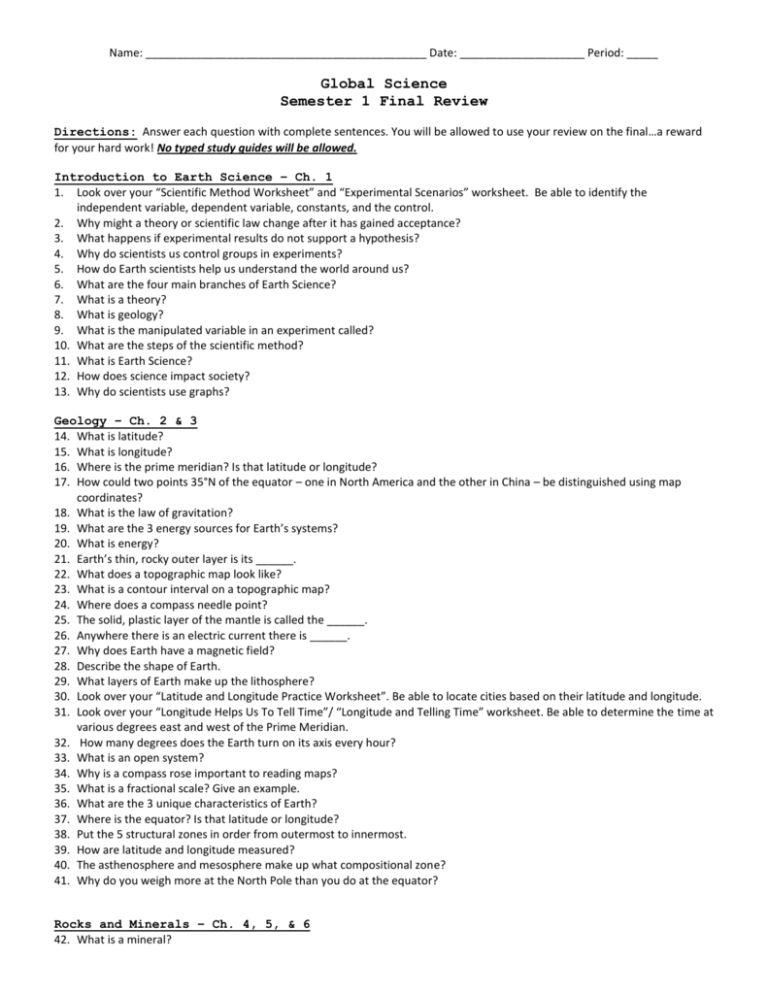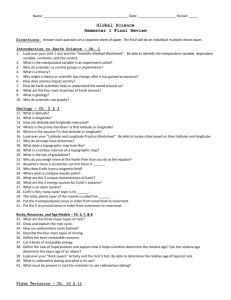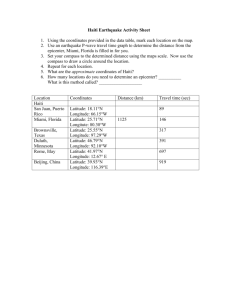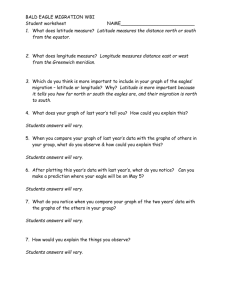Name: Date: Period: _____ Global Science Semester 1 Final
advertisement

Name: _____________________________________________ Date: ____________________ Period: _____ Global Science Semester 1 Final Review Directions: Answer each question with complete sentences. You will be allowed to use your review on the final…a reward for your hard work! No typed study guides will be allowed. Introduction to Earth Science – Ch. 1 1. Look over your “Scientific Method Worksheet” and “Experimental Scenarios” worksheet. Be able to identify the independent variable, dependent variable, constants, and the control. 2. Why might a theory or scientific law change after it has gained acceptance? 3. What happens if experimental results do not support a hypothesis? 4. Why do scientists us control groups in experiments? 5. How do Earth scientists help us understand the world around us? 6. What are the four main branches of Earth Science? 7. What is a theory? 8. What is geology? 9. What is the manipulated variable in an experiment called? 10. What are the steps of the scientific method? 11. What is Earth Science? 12. How does science impact society? 13. Why do scientists use graphs? Geology – Ch. 2 & 3 14. What is latitude? 15. What is longitude? 16. Where is the prime meridian? Is that latitude or longitude? 17. How could two points 35°N of the equator – one in North America and the other in China – be distinguished using map coordinates? 18. What is the law of gravitation? 19. What are the 3 energy sources for Earth’s systems? 20. What is energy? 21. Earth’s thin, rocky outer layer is its ______. 22. What does a topographic map look like? 23. What is a contour interval on a topographic map? 24. Where does a compass needle point? 25. The solid, plastic layer of the mantle is called the ______. 26. Anywhere there is an electric current there is ______. 27. Why does Earth have a magnetic field? 28. Describe the shape of Earth. 29. What layers of Earth make up the lithosphere? 30. Look over your “Latitude and Longitude Practice Worksheet”. Be able to locate cities based on their latitude and longitude. 31. Look over your “Longitude Helps Us To Tell Time”/ “Longitude and Telling Time” worksheet. Be able to determine the time at various degrees east and west of the Prime Meridian. 32. How many degrees does the Earth turn on its axis every hour? 33. What is an open system? 34. Why is a compass rose important to reading maps? 35. What is a fractional scale? Give an example. 36. What are the 3 unique characteristics of Earth? 37. Where is the equator? Is that latitude or longitude? 38. Put the 5 structural zones in order from outermost to innermost. 39. How are latitude and longitude measured? 40. The asthenosphere and mesosphere make up what compositional zone? 41. Why do you weigh more at the North Pole than you do at the equator? Rocks and Minerals – Ch. 4, 5, & 6 42. What is a mineral? 43. 44. 45. 46. 47. 48. 49. 50. 51. What is metamorphism? What are the 2 most common elements in Earth’s crust? What is the smallest unit of an element that keeps all of the chemical properties of a substance? How many elements make up 98% of Earth’s crust? What is an ionic bond? What are the 2 main groups of minerals? What are the 3 types of subatomic particles? How are sedimentary rocks formed? What 2 subatomic particles occur in equal numbers in an uncharged atom? Plate Tectonics – Ch. 10 & 11 52. What 4 pieces of evidence to Wegner use to support his hypothesis? 53. What was Alfred Wegner’s hypothesis called? 54. What is sea-floor spreading? 55. Why was sea-floor spreading an important discovery? 56. What is a transform boundary? 57. What causes a supercontinent to break apart? 58. What are tectonic plates? 59. Deep-ocean trenches commonly form at what type of boundary? 60. What are mid-ocean ridges? 61. What is subduction? 62. What is stress? 63. What happens when two oceanic plates collide? 64. What happens when continental plates collide? 65. How are faults different than folds? 66. What is isostasy? 67. What is compression? 68. What are the 4 types of mountains? 69. What is located at the center of a mid-ocean ridge? Earthquakes and Volcanoes – Ch. 12 & 13 70. Is earthquake prediction reliable? 71. What are seismic waves? 72. Why do earthquakes usually occur at plate boundaries? 73. What is elastic rebound? 74. Which magnitude scale do scientists prefer to use? 75. What is the epicenter of an earthquake? 76. What is a foreshock? 77. What type of waves are the slowest moving, but potentially the most harmful? 78. How is lag time and distance to an epicenter related? 79. How do scientists find the distance to an epicenter? 80. What happens to a rock when its temperature rises above its melting point? 81. What is a hot spot? 82. What is volcanism? 83. What is a tsunami? 84. Earthquakes that do the most damage usually have a(n) ________ focus? 85. What things might signal the eruption of a volcano? 86. What happens if a fault is locked? 87. What are the 3 types of volcanic cones? 88. Where are volcanoes formed? (3 places) 89. What type of lava causes a quiet eruption? 90. What type of lava causes an explosive eruption? 91. Why does magma rise? 92. What happens when an oceanic and continental plate collide? 93. Is panicking a good idea during a natural disaster?









